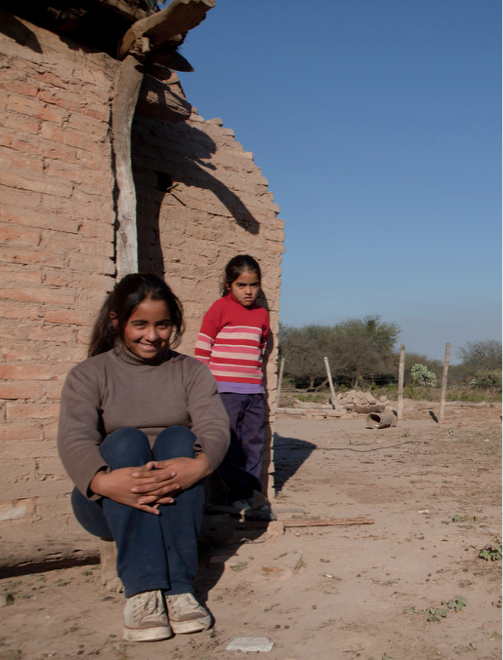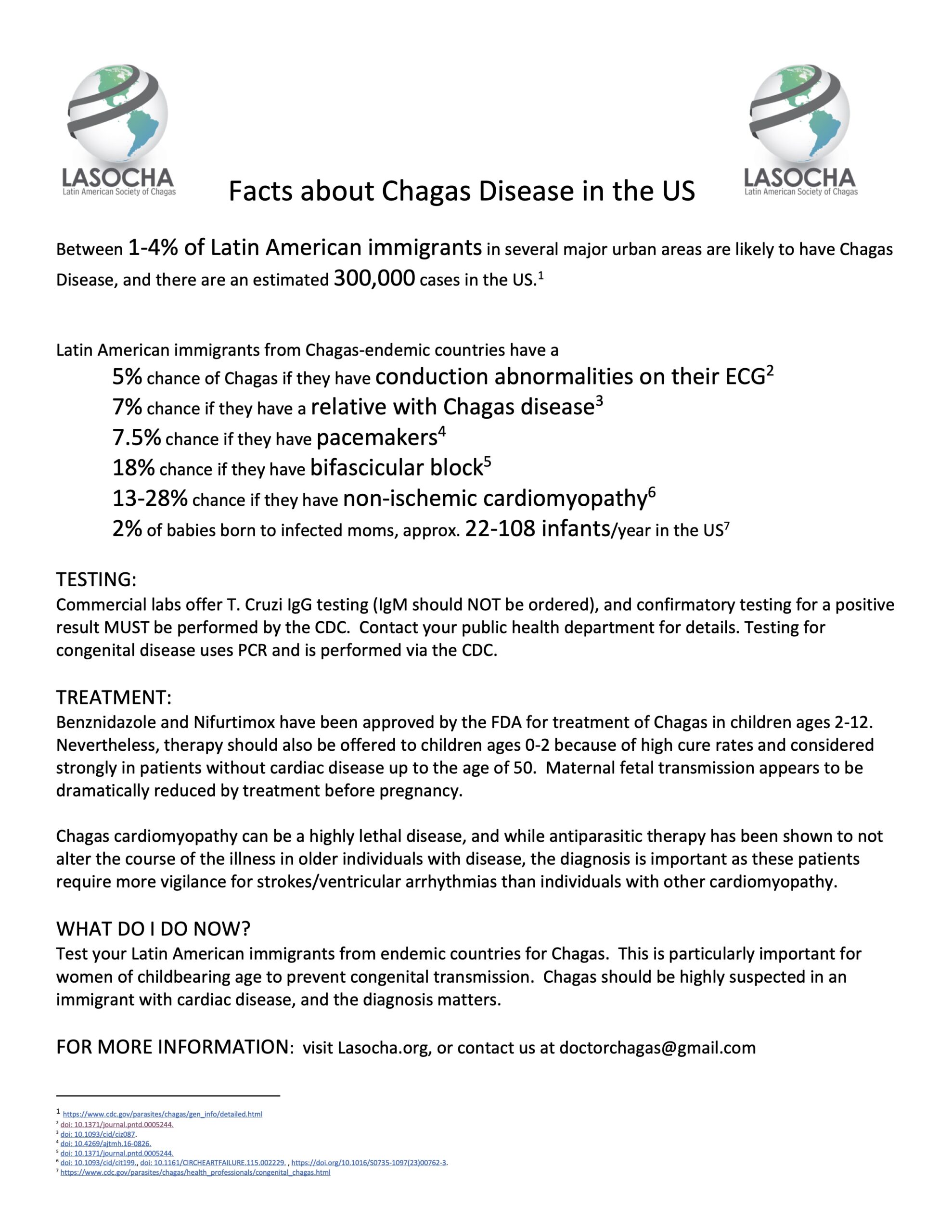Diagnosing Chagas disease
Chagas disease is a parasitic infection generally acquired in childhood that can cause cardiac and gastrointestinal complications many years after infection. Associated with having lived in rural poverty in Latin America, Chagas disease is transmitted by triatomine insects whose infected feces contaminate their bite wounds. After inoculation, the disease progresses in 3 distinct phases.
Acute Disease:
Not recalled by many because of non-specific symptoms, acute Chagas disease is a frequently febrile illness, accompanied often by induration of the inoculation site. Lymphadenopathy and malaise are also common.
In less than 5% of patients a more severe acute disease with cardiac manifestation, hepatosplenomegaly, or meningoencephalitis.
Indeterminate Phase:
After the acute illness, all patients who do not receive antiparasitic therapy either develop incipient cardiac complications or remain infected without end organ disease.
Those who have positive serology for T. Cruzi infection but normal ECGs/GI studies are classified as having indeterminate phase disease, but approx. 2%/year will develop new ECG abnormalities.
Chronic Phase:
This stage is defined as at a minimum having an abnormal ECG in the setting of positive serologic testing for Chagas disease.
Generally after 15-30 years, approx. 30 % of infected patients will have cardiac complications of the disease, ranging from asymptomatic ECG abnormalities to strokes, life threatening bradyarrhythmias or tachyarrhythmias, and heart failure. Gastrointestinal disease is less common, (10%), and can lead to symptoms of achalasia (megaesophagus), or profound constipation occasionally leading to volvulus (megacolon).
Congenital Chagas disease:
Because of transplacental transmission, congenital Chagas disease can occur in 1-5% of pregnancies if the mother is infected. While generally asymptomatic, babies can be born prematurely and ill. For more information, please review the CDC webpage.
Who should be screened?
Any Latin American immigrant from a non-island country is at risk for Chagas disease, and ideally screening should be offered to all.
In resource limited environments, there are predictors of disease that can be considered: while there are certain regions within each country that are more likely to be associated with vector exposure, the lack of comprehensive prevalence data complicates using region of origin as a risk stratifier for disease.
Patients who recognize the insect, have heard of Chagas disease, and who have a relative with Chagas are at higher risk for having the infection. Because of the ability to prevent maternal fetal transmission if antiparasitic therapy is administered to women of childbearing age prior to conception, the CDC and many Latin American countries recommend routine screening in this population. Immigrants with cardiac or gastrointestinal disease suggestive of Chagas should be screened. These include stroke, brady or tachyarrhythmias, conduction abnormalities on ECG (specifically RBBB and/or LAFB), heart failure, achalasia, megacolon.
How do I test my patients for Chagas disease?
The vast majority of individuals living with Chagas disease in the United States are in the chronic phase of the illness, during which time parasitemia is modest and sporadic. Testing is therefore based on serologic analysis looking for IgG antibodies against T. cruzi. Because of imperfect test performance, the diagnosis of Chagas disease can only be made after 2 serologic analyses show positive results. These may either be 2 ELISAs with different antigen profiles, or an ELISA and a different assay (i.e. TESA, IFA).
In the setting of concern for acute disease, either in a newborn or reactivation illness, different testing protocols must be employed, using the CDC lab. For congenital Chagas, serologic assays are insufficient, as maternal antibody can be present, therefore testing includes buffy coat/PCR at birth and serologic testing at 9-12 months if initial testing is negative. In the setting of reactivation, assessment should be made by buffy coat analysis and PCR. Consultation with an infectious disease physician familiar with Chagas disease and the CDC (parasites@cdc.gov; 1-404-718-4745) is appropriate for the details of testing protocols.
The tests that are employed by the commercial laboratories change sporadically, as of the time of the most recent website update Quest and Mayo Clinic labs utilize the Weiner 3.0 ELISA, and ARUP (and therefore Labcorp) the Hemagen ELISA. The choice of assay can change frequently, however, and is often not publicized, so you may wish to check with your lab to make sure you know which test is currently being used.
A positive test from a commercial lab does not make the diagnosis of Chagas disease, and must be confirmed by additional analysis, best performed by the CDC, which currently employs the Weiner ELISA and the TESA Western Blot, and can perform an IFA if there are conflictual results. This testing requires preapproval, and additional advice about testing can be obtained at parasites@cdc.gov or 1-404-718-4745.
You are also welcome to contact Dr. Rachel Marcus to discuss a case.
What do I do if my patient is confirmed to have Chagas disease by CDC confirmation?
A patient who has been confirmed to have Chagas disease should have an ECG, and preferably also an echocardiogram, to look for signs of cardiac damage.
Individuals with cardiac symptoms and normal cardiac tests along with individuals with abnormal cardiac tests should be evaluated by a cardiologist, preferably one with experience treating Chagas patients. A review of the management of Chronic Chagas Cardiomyopathy can be found at JACC and Circulation. If there are gastrointestinal symptoms a barium enema or barium swallow is indicated, along with consultation with a gastroenterologist. If the patient does not have demonstrable end organ involvement consideration should be given to administration of antiparasitic therapy.
If you would like to speak with an expert about your patient, please email Dr. Rachel Marcus, or to look for a doctor knowledgeable about Chagas, contact the US Chagas Network.
Treating Chagas disease
Treatment is recommended for:
All children younger than 18 years of age with chronic T. cruzi infection
All children younger than 18 years of age with acute or congenital T. cruzi infection
Reactivated infection in association with immunosuppression
There is currently only one FDA approved medication for the treatment of Chagas disease in children ages 2-12.*
Benznidazole is highly effective at causing seronegativization in newborns, acute disease, and recently infected children. It is significantly less effective in adults with indeterminate phase disease, and randomized trial evidence is lacking to address clinical response to therapy in this group. In a randomized trial (BENEFIT project) of patients with established cardiac disease, no benefit of anti-parasitic therapy was noted (N Engl J Med).
*While approved based on studies of patients ages 2-12, this medication is used in all age groups.
When to prescribe anti-parasitic therapy in adults is a more complicated and controversial question, particularly in light of the high rate of side effects and the lack of randomized trial data to support treatment in most settings. With the evidence that seronegativization occurs more often in the young, many Chagas experts support offering therapy to adults up to the age of 50, with individualized decision-making for those between 50-60. (JAMA) Given data that suggests that most Chagas related mortality occurs before the age of 60, in general medication should not be offered to those above this age. A stronger case can be made for treating any woman of childbearing age, as there are two observational studies that show a strong association between antiparasitic therapy and reduction in the risk of maternal-fetal transmission. The medication should not be given during pregnancy or lactation.
Anti Parasitic treatment in patients with established cardiac involvement
The BENEFIT Project randomized trial has addressed the role of antiparasitic therapy in patients with cardiac manifestations of Chagas disease. (N Engl J Med) While the average age was 55 years old, leading some to feel that much younger patients may not have been appropriately represented, the findings showed no clinical benefit in terms of cardiac endpoints after 5-7 years of follow up. Anti-parasitic therapy, therefore, should not be offered routinely to patients with cardiac disease, though consultation with a specialist may be appropriate if the patient is very young.
The following is an excerpt from a chart outlining Chagas disease treatment guidelines under the below settings. The full chart is in a PAHO document called Guidelines for the Diagnosis and Treatment of Chagas Disease.
Guidelines for the Diagnosis and Treatment of Chagas Disease
Pan American Health Organization
https://iris.paho.org/bitstream/handle/10665.2/49653/9789275120439_eng.pdf.
Pg. 13
Guía para el diagnóstico y el tratamiento de la enfermedad de Chagas
Organización Panamericana de la Salud
https://iris.paho.org/bitstream/handle/10665.2/49653/9789275320433_spa.pdf
Physician Resources
As part of our commitment to increase awareness in the community, we have compiled some resources about Chagas disease at the following link. Please inform us if you have other suggested links and comments to add.
Provider Resources
Join the Physician Network
If you would like to join the Chagas US physician network, please refer to the US Chagas Network website.
Becoming part of the US Chagas network will help you to be updated with the latest information about Chagas in the United States.
Provider and Community Outreach

At times, events are held in an effort to increase physician and community Chagas disease awareness. If you are interested in having someone from LASOCHA address your group, please contact us at this link.
If you are interested in learning more right away, you can find Dr. Marcus’s YouTube channel, as well as some Chagas disease related talks and publications, in the links below.
Videos
Related Publications
Halaseh, R, Shehadeh, M, Marcus, R. Multiple Strokes in a Latin American Patient. Case Rep Neurol. 2021 May-Aug;13(2):441-445.
Diagnosing Chagas Disease
Chagas disease is a parasitic infection generally acquired in childhood that can cause cardiac and gastrointestinal complications many years after infection. Associated with having lived in rural poverty in Latin America, Chagas disease is transmitted by triatomine insects whose infected feces contaminate their bite wounds. After inoculation, the disease progresses in 3 distinct phases.
Acute Disease:
Not recalled by many because of non-specific symptoms, acute Chagas disease is a frequently febrile illness, accompanied often by induration of the inoculation site. Lymphadenopathy and malaise are also common.
In less than 5% of patients a more severe acute disease with cardiac manifestation, hepatosplenomegaly, or meningoencephalitis.
Indeterminate Phase:
After the acute illness, all patients who do not receive antiparasitic therapy either develop incipient cardiac complications or remain infected without end organ disease.
Those who have positive serology for T. Cruzi infection but normal ECGs/GI studies are classified as having indeterminate phase disease, but approx. 1.5-5%/year will develop new ECG abnormalities.
Chronic Phase:
This stage is defined as at a minimum having an abnormal ECG in the setting of positive serologic testing for Chagas disease.
Generally after 15-30 years, approx. 30 % of infected patients will have cardiac complications of the disease, ranging from asymptomatic ECG abnormalities to strokes, life threatening bradyarrhythmias or tachyarrhythmias, and heart failure. Gastrointestinal disease is less common, (10%), and can lead to symptoms of achalasia (megaesophagus), or profound constipation occasionally leading to volvulus (megacolon).
Congenital Chagas disease:
Because of transplacental transmission, congenital Chagas disease can occur in 3-5% of pregnancies if the mother is infected. While generally asymptomatic, babies can be born prematurely and ill. For more information, please review the CDC webpage.
Who should be screened?

Any Latin American immigrant from a non-island country is at risk for Chagas disease, and ideally screening should be offered to all.
In resource limited environments, there are predictors of disease that can be considered: while there are certain regions within each country that are more likely to be associated with vector exposure, the lack of comprehensive prevalence data complicates using region of origin as a risk stratifier for disease.
Patients who recognize the insect, have heard of Chagas disease, and who have a relative with Chagas are at higher risk for having the infection. Because of the ability to prevent maternal fetal transmission if antiparasitic therapy is administered to women of childbearing age prior to conception, the CDC and many Latin American countries recommend routine screening in this population. Immigrants with cardiac or gastrointestinal disease suggestive of Chagas should be screened. These include stroke, brady or tachyarrhythmias, conduction abnormalities on ECG (specifically RBBB and/or LAFB), heart failure, achalasia, megacolon.
How do I test my patients for Chagas Disease?
The vast majority of individuals living with Chagas disease in the United States are in the chronic phase of the illness, during which time parasitemia is modest and sporadic. Testing is therefore based on serologic analysis looking for IgG antibodies against T. cruzi. Because of imperfect test performance, the diagnosis of Chagas disease can only be made after 2 serologic analyses show positive results. These may either be 2 ELISAs with different antigen profiles, or an ELISA and a different assay (i.e. TESA, IFA).
In the setting of concern for acute disease, either in a newborn or reactivation illness, different testing protocols must be employed, using the CDC lab. For congenital Chagas, serologic assays are insufficient, as maternal antibody can be present, therefore testing includes buffy coat/PCR at birth and serologic testing at 9-12 months if initial testing is negative. In the setting of reactivation, assessment should be made by buffy coat analysis and PCR. Consultation with an infectious disease physician familiar with Chagas disease and the CDC Chagas desk is appropriate for the details of testing protocols.
The tests that are employed by the commercial laboratories change sporadically, though currently all of the commercial labs in the United States are using the Hemagen ELISA assay. Mayo Clinic is currently offering Inbios rapid essay, if Hemagen ELISA assay is positive (test specificity is under evaluation). Given incomplete data about the test performance of other assays that are available in the U.S., a positive test from a commercial lab should be currently be confirmed by analysis at the CDC, which currently employs the Weiner ELISA and the TESA Western Blot. More information about how to order confirmatory testing can be found here (in bold, will link to the section What do I do if my patient tests positive). Additional advice about testing can be obtained at the CDC Help Desk.
What do I do if my patient is confirmed to have Chagas disease by CDC confirmation
A patient who has been confirmed to have Chagas disease should have an ECG, and preferably also an echocardiogram, to look for signs of cardiac damage.
Individuals with cardiac symptoms and normal cardiac tests along with individuals with abnormal cardiac tests should be evaluated by a cardiologist, preferably one with experience treating Chagas patients. A review of the management of Chronic Chagas Cardiomyopathy can be found at JACC and Circulation. If there are gastrointestinal symptoms a barium enema or barium swallow is indicated, along with consultation with a gastroenterologist. If the patient does not have demonstrable end organ involvement consideration should be given to administration of antiparasitic therapy.
If you would like to speak with an expert about your patient, please use this for email to Rachel, or to look for a doctor with experience with Chagas, for Caryns email.
Treating Chagas Disease
Treatment is recommended for:
All children younger than 18 years of age with chronic T. cruzi infection
All children younger than 18 years of age with acute or congenital T. cruzi infection
Reactivated infection in association with immunosuppression
There is currently only one FDA approved medication for the treatment of Chagas disease in children ages 2-12.* Benznidazole is highly effective at causing seronegativization in newborns, acute disease, and recently infected children. It is significantly less effective in adults with indeterminate phase disease, and randomized trial evidence is lacking to address clinical response to therapy in this group. In a randomized trial of patients with established cardiac disease, no benefit of anti-parasitic therapy was noted.
*While approved based on studies of patients ages 2-12, this medication is used in all age groups.
When to prescribe anti-parasitic therapy in adults is a more complicated and controversial question, particularly in light of the high rate of side effects and the lack of randomized trial data to support treatment in most settings. With the evidence that seronegativization occurs more often in the young, many Chagas experts support offering therapy to adults up to the age of 50, with individualized decision-making for those between 50-60. (JAMA) Given data that suggests that most Chagas related mortality occurs before the age of 60, in general medication should not be offered to those above this age. A stronger case can be made for treating any woman of childbearing age, as there are two observational studies that show a strong association between antiparasitic therapy and reduction in the risk of maternal-fetal transmission. The medication should not be given during pregnancy or lactation.
Anti Parasitic treatment in patients with established cardiac involvement
A randomized trial has addressed the role of antiparasitic therapy in patients with cardiac manifestations of Chagas disease. (BENEFIT) While the average age was 55 years old, leading some to feel that much younger patients may not have been appropriately represented, the findings showed no clinical benefit in terms of cardiac endpoints after 5-7 years of follow up. Anti-parasitic therapy, therefore, should not be offered routinely to patients with cardiac disease, though consultation with a specialist may be appropriate if the patient is very young.
The following chart shows recommendations as per the PAHO/WHO guidelines for Chagas Disease treatment under the below settings:
Physician Resources
As part of our commitment to increase awareness in the community, medical professionals can find a wealth of knowledge about Chagas Disease in the following documents and links. Make sure to review the following articles to learn the latest about Chagas Disease.
Centros para el Control y la Prevención de Enfermedades
OPS
Texas Chagas Taskforce
Kissing bugs and CD in the US
CECD
Coalicion Chagas
Chagas disease ECHO Project
DNDi Chagas
Mundo Sano
Benznidazole Tablets
Join the physician Network
If you would like to join the Chagas US physician network, please refer to the US Chagas Network website.
Becoming part of the US Chagas network will help you to be updated with the latest information about Chagas in the United States.
Upcoming CME and Physician Education

In an effort to increase physician awareness for Chagas disease.
This section contains the upcoming seminars that are available for the medical community in the United States.



